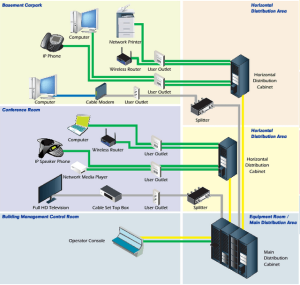
What is Certification and is it really necessary?
Environmental Problems with Cat5e, Cat6, and Cat6A Cable
Cable must be installed so that external environmental factors do not have an effect on the performance of the network. Problems can occur at the patch panel punch down, at the wall plate jack and anywhere along the cable itself. Maybe an inadvertent kink is in the cable. Or there is a snag in the cable as it got pulled across a rough surface in the rafters above the drop ceiling. Or maybe the cable got too close to an electric line. Any one of these issues can degrade the performance of an individual cable.
There are two basic kinds of testing that is performed during the installation of cabling:
- Continuity Testing
- Certification
Continuity Testing
Continuity Testing is a test to insure that the wires in the connectors at the faceplate and at the patch panel are connected up correctly. There are 4 pairs of wires and each wire is color-coded. So, as the technician is connecting everything, a particular sequence is required. If a wire is connected in the wrong order, the cable will fail. This is a basic wire-mapping test. If this test fails, the connector and wires are re-examined and re-terminated. All of our cable installations include continuity testing.
But the only way to insure and guarantee full speed to every cable is to do Certification Testing on each cable.
Certification
Certification Testing is a performance test that utilizes a precision device that sends a signal from one end of the cable to the other. This test is the only way to test the data-carrying capacity of each cable. For example, Cat6A cable is rated to run at 10G/sec. But if you have an issue, the cable will work but it might be running at a slower speed. It passes the continuity test but it's not performing at 100%. Certification will find the fault, pin-pointed to its exact location so that our technician can fix it, retest it and fully certify it as 100% top-speed rated.
The Fluke DSX-5000 is a very expensive test device that we employ to test and certify our cabling jobs. It costs about an extra $10 per cable to get everything tested and certified. But without this test, we can't guarantee top speeds throughout your network. And, considering that most cabling projects have a useful lifespan of 15 - 20 years, this investment upfront is very cost-effective. It means you will have full speed to every device for the entire lifetime of your cabling infrastructure.
Certification includes a PDF report showing every cable and the test results.
Do you have an upcoming cabling project?


 enhances air circulation and cable ventilation. This can be appropriate beneath desks, elevated floors, or hanging tray systems. You can assemble basket trays for intersections, horizontal sections, mounting braces, hardware, and tray cutters.
enhances air circulation and cable ventilation. This can be appropriate beneath desks, elevated floors, or hanging tray systems. You can assemble basket trays for intersections, horizontal sections, mounting braces, hardware, and tray cutters.

 Data volume has grown extensively. Also, the processing capacity to users continues to get grow. Specialists in
Data volume has grown extensively. Also, the processing capacity to users continues to get grow. Specialists in 
 t connects personal computers to the wall plate or provides the short interconnects among the switches, routers and the patch panels in the wall closet or Server Room. These make use of stranded wires instead of solid to increase flexibility. It also lessens the risk of cracking when you unplug the cable. There is also a variety of Ethernet patch called the crossover cable. It is used to hook up two PCs together and sometimes to interconnect switches.
t connects personal computers to the wall plate or provides the short interconnects among the switches, routers and the patch panels in the wall closet or Server Room. These make use of stranded wires instead of solid to increase flexibility. It also lessens the risk of cracking when you unplug the cable. There is also a variety of Ethernet patch called the crossover cable. It is used to hook up two PCs together and sometimes to interconnect switches.
 Riser cables were designed for non-plenum vertical applications like between the floors of multi-story buildings. They are also described as backbone cables. These
Riser cables were designed for non-plenum vertical applications like between the floors of multi-story buildings. They are also described as backbone cables. These 
 It can lead to a lot of negative outcomes such as paralyzed
It can lead to a lot of negative outcomes such as paralyzed 



